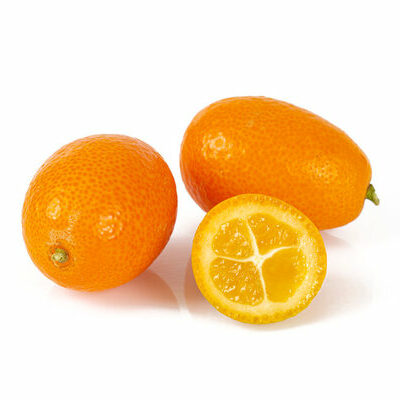
Kumquat
What is Kumquat?
Kumquat (Citrus japonica) is a citrus fruit that closely resembles the orange in color and shape. However, it is smaller than an orange and may also be oblong. The name of the fruit comes from a Cantonese word ‘kamkwat’, which means ‘golden orange’. This fruit has a distinct citrusy flavor and notes of sweet, sour, and tangy.
- The peel of the fruit is very sweet as well, and is also consumed.
- While they are mostly consumed raw, these citrus fruits may be used in cooking different dishes like salads, desserts, or cocktails.
The top 15 most popular Asian fruits are:
- Pomelo
- Jackfruit
- Wax Apple
- Lychee
- Rambutan
- Durian
- Asian Pear
- Mangosteen
- Guava
- Lotus Fruit
- Sugar Apple
- Chinese Bayberry
- Starfruit
- Pulasan
- Kumquat
Origin of kumquats
This fruit is native to China. Chinese literature from the 12th century makes references to this fruit. Later on, it spread to Japan and was included in a list of plants cultivated in the country in the 1700s. Also, it was cultivated in India, Taiwan, and the Philippines. Portuguese missionaries brought the fruit back to Europe, from where it spread to the Americas. Today, it remains popular in the North American state of Florida.
Nutrition
Nutritional profile for kumquat (1 fruit):

Kumquats are also rich in micronutrients such as calcium, magnesium, potassium, phosphorus, vitamin C, folate, folic acid, carotene, vitamin A, and lutein + zeaxanthin. In addition, this citrus fruit is a significant component of folk medicine in some countries. The fruit has antibacterial and antimicrobial properties. It can assist in managing alcohol intoxication and depression. The carotenoids and flavonoids in the fruit may help in preventing cancer, diabetes, and rheumatism.
Commercial production
The main varieties of commercial kumquats are Hong Kong, Marumi, Meiwa, and Nagami. Though the fruit can withstand frost, they grow best in warm climates. They are usually not grown from seed but grafted onto the trifoliate orange tree. Furthermore, the fruit trees often grow together in groups, with each tree producing hundreds of fruits each season. This citrus fruit can be stored in the refrigerator for up to one week.
Kumquat recipes
The best way to eat kumquats is to squeeze out the juice, which is sour, and just eat the skin. They are excellent for making marmalades, jams, and preserves. This fruit is suitable for glazing meat, cooking into soups and stews, and adding into salads. Candied and dried varieties are also popular. Here are some recipes:
- Kumquat Marmalade
- Kumquat Jam
- Candied Kumquats
- Basil Chicken
- Kumquat Tart
- Pepper Crusted Beef Tenderloin
- Fresh Herb Salad
- Asian Chicken
- Glazed Salmon
- Salmon Yakisoba
- Stir Fried Duck
- Ginger Cake
- Kumquat Curd
FDA regulations
The FDA describes all fresh fruits, including kumquats, as raw agricultural commodities. Therefore, the organization strictly regulates all aspects of its growing, harvesting, packing, and storage.
References
Julia F Morton (1987). “Kumquat, Fortunella sp. Swingle; In: Fruits of Warm Climates, Miami, FL”. NewCROP, New Crop Resource Online Program, Center for New Crops and Plant Products, Purdue University. pp. 182–185. Retrieved 3 January 2020., https://hort.purdue.edu/newcrop/morton/kumquat.html
Pinheiro-Sant’Ana, Helena Maria et al. “Quali-Quantitative Profile of Native Carotenoids in Kumquat from Brazil by HPLC-DAD-APCI/MS.” Foods (Basel, Switzerland) vol. 8,5 166. 16 May. 2019, doi:10.3390/foods8050166, https://www.ncbi.nlm.nih.gov/pmc/articles/PMC6560404/
